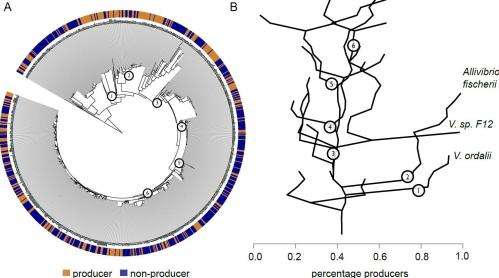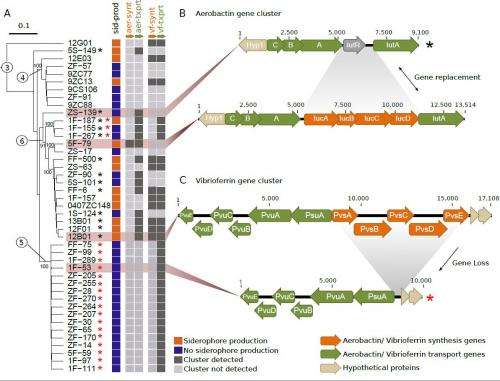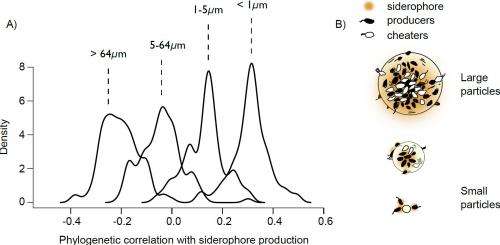December 13, 2012 feature
Microbial Munificence: Iron acquisition strategies in natural bacterioplankton populations

(Phys.org)—Of the many microbes that – like almost all life – require iron, some live in iron-limited environments. What to do? Secrete siderophores, of course: small, high-affinity iron chelating compounds that scavenge the poorly-soluble Fe3+ iron ion from the environment and make it available to cells through active transport – a process in which a cell moves a substance across a membrane from a region of lower concentration to a one of higher concentration. Interestingly, iron-carrying siderophores can be seen in an economic context as diversification-supporting public goods that can be used advantageously by bacterial populations. (In economic terms, public goods can be consumed by additional consumers without additional cost.) Historically, it's been unclear whether or not wild microbial communities can be stable enough for evolutionary diversification to be influenced by social interaction between them. Recently, however, scientists at the Massachusetts Institute of Technology demonstrated that game theory can provide mathematical expectations consistent with the observation that groups of siderophore-nonproducing Vibrionaceae marine bacteria not only still had siderophore transport capability, but tended to associate with siderophore-producing populations. The researchers suggest that the non-producers have evolved a cheating strategy in which they and the siderophore-producing populations have evolved to be co-dependent.
Professor Martin F. Polz and Postdoctoral Associate Otto X. Cordero discuss the challenges they and their colleagues, Professor Edward F. DeLong and graduate student Laure-Anne Ventouras, encountered in conducting the study. "Social interaction between microbes – in particular those mediated by public goods such as siderophores – have been studied in recent years in using laboratory systems like E. coli," Cordero tells Phys.org. "However, nothing, or very little was known for natural populations of bacteria." Cordero further stresses that there are multiple important differences between what happens in a clonal bacterial lab population and what happens in wild, non-clonal populations living in extremely heterogeneous environments. "In fact," Polz adds, "we showed earlier that the wild, populations of bacteria consist of highly heterogeneous individuals with up to 20 percent differences in genome size."
"So," Cordero continues, "that's the big challenge: how to get at what's happening with wild microbes?" This is difficult indeed, because the study – unlike research focused on larger animals, from ants to zebra – required the scientists to track interactions between cells in their native marine environment. "To be able to establish the frequency and genetic basis of pubic goods production, we had to study over 1,000 individuals taken from a natural oceanic population of Vibrio bacteria." Since the researcher knew the bacteria's exact microenvironmental origins, they were able to calculate statistical associations with microenvironments of specific genotypes. In addition, it was necessary to study the genome sequences of more than 60 of these bacteria.
"Putting these pieces together," Cordero explains, "we were able to reconstruct a picture that was consistent with expectations from public good game theory. This is exciting, because we could show that part of the genetic diversity of these populations is driven by the dynamics of public good games. In fact, this is one of the few cases scientists have been able to link genomic diversity in microbes to the processes like social interactions.

In addressing these challenges, notes Polz, one of the researchers' key insights was that public goods interactions can structure bacterial populations in the wild. "This was not clear, since for such interactions to develop, fairly stable interactions need to develop among heterogeneous individuals," Polz. "It was especially doubtful whether public good dynamics would ensue in the ocean, since it represents a fairly dilute and well-mixed environment."
Cordero points out that their discovery was made possible by the application of high-throughput siderophore production screening techniques in combination with genome sequencing and comparative genome analysis. "Moreover," he adds, "we carefully documented the microenvironments where the bacteria where collected, allowing us to establish the link between social cheating and marine microenvironment."
Cordero also notes that the outcome of public good games, in terms of the relative abundance of cooperators and cheaters, is affected by the population dynamics. "Stable, dense populations tend to favor cheaters, while population fluctuations favor cooperators, because public goods producers grow better during population bottlenecks. Therefore, bacteria that evolved to attach to larger particles with dense microbial communities tend to evolve cheating behavior, whereas bacteria that evolved to exploit transient patches of nutrients tend to produce public goods." Moreover, he adds, they found the transition from cheating to cooperative behavior occurs by gene gain and loss. Bacteria can have extremely rapid genetic content turnover, thereby generating diversity. Therefore, the emergence of social roles due to public good interactions is coupled to the generation of diversity in the genomes.
Discussing the study's suggestion that these can harbor stable enough communities for dependencies among organisms to evolve, Cordero again emphasizes that it is counterintuitive that microbes can engage in social interactions in an environment such as the ocean. "Our findings show that these interactions are relevant and that they drive diversity. This is likely because, for a microbe, the marine environment is formed of patches of nutrients where dense communities establish and where interactions can take place."

In terms of next steps, Cordero refers to their paper, in which the team reported an interesting correlation between the frequency of social cheaters and the particle size where the bacteria where collected. "Microbes such as Vibrio tend to live attached to particles in the marine environment," recounts Cordero. "Particle size could have consequences for the physics of public goods diffusion, the rate of bacteria colonization, and other factors that can all affect microbial population dynamics. Our results show that larger, more densely populated particles in the marine environment have a higher proportion of cheaters and represent hotspots of social interactions. This is an interesting link between physics and biology, as well with how current efforts are aimed at testing these hypotheses in vitro."
Cordero also sees the potential for other areas of research to benefit from their findings. "We hope that our study shows the importance of population level processes and interactions in ecological function," he concludes. "Microbiology in general builds on reductionist models that look only at the function of individuals – that is, clones. Our work instead shows that some traits can only be understood when we study populations of heterogeneous individuals."
More information: Public good dynamics drive evolution of iron acquisition strategies in natural bacterioplankton populations, PNAS published online before print November 19, 2012, doi:10.1073/pnas.1213344109
Journal information: Proceedings of the National Academy of Sciences
Copyright 2012 Phys.org
All rights reserved. This material may not be published, broadcast, rewritten or redistributed in whole or part without the express written permission of Phys.org.












.jpg)





